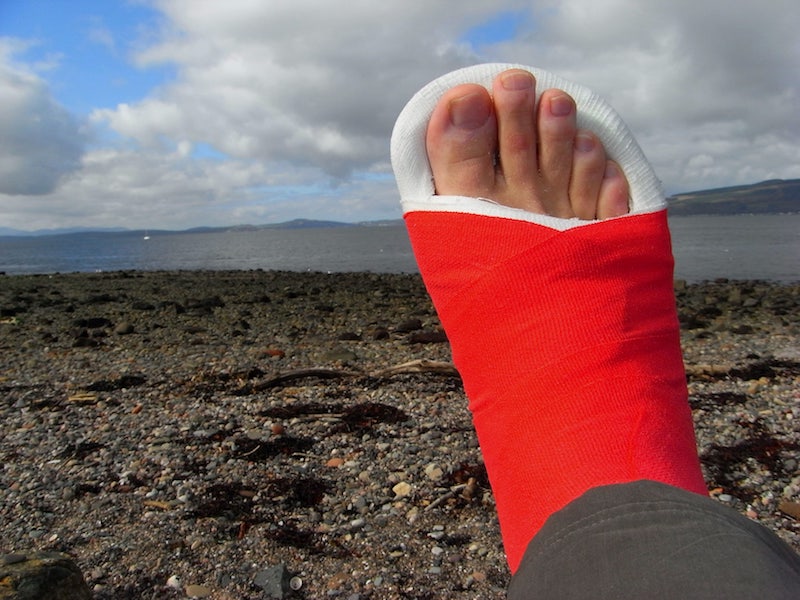I Tripped Today: How to Avoid Falls
October 31, 2013 4 min read

I tripped today. That is not a good thing for somebody who has osteoporosis.
Someone placed a rock right at the edge of the sidewalk. Indeed, the rock should not have been put there, but I was walking fast and when I turned right to go down the next street, I did not notice the rock and I tripped.
Fortunately, I did not fall this time. Was this near fall preventable? In this case, I think it was avoidable. The exercise of asking myself this question is not to lay blame, but rather to increase my awareness so that I can avoid a similar situation the future.
Those who have been diagnosed with osteoporosis and especially those who have sustained a recent fracture often live with a fear of falling. This fear is understandable, but there are things we can do to lessen this fear. The top two things we can do are to work on balance and to be mindful when we are moving.
Studies have shown that
90% of hip fractures occur because people fall.
It would be interesting to do a study of 1,000 people who practice balance exercises and mindful walking compared with 1,000 people who did not incorporate these practices. My guess is, fractures would be reduced significantly in the mindful group.
Most falls can be avoided.
One of my patients told me that she fell 2-3 times every year. When I inquired about why she fell she said the sidewalks in Berkeley are bad. This is true, sidewalks in Berkeley are bad, which means that you really must pay attention when walking. On my street the sidewalk is very uneven in spots, due to tree roots that have pushed up sidewalk sections. I have stumbled more than once. Another added hazard is that the street is very dark at night.
When a patient reports to me that they have fractured a bone, I ask why?
Reasons patients have shared with me about how they fractured a bone:
- A 68-year-old woman broke her ankle after tripping on a rug that was not secured on a hardwood floor.
- An 82-year-old woman broke her shoulder following a fall on stairs - she was distracted and missed a step, resulting in a horrible fall.
- One man broke two vertebrae after lifting a 50-pound box at arms length while twisting.
- A woman was walking in the dark and she tripped and fell hard on the sidewalk and broke her hip.
- A 52-year-old woman fractured her rib during a yoga class that was too advanced for a beginner.
- A 69-year-old woman broke her wrist while hiking with a friend. She lost her balance and fell while engrossed in a conversation.
All though accidents do happen, there are many things that come into play when thinking about fall prevention.
How to avoid falling with osteoporosis:
- If your balance is poor, work on balance exercises.
- Carry a flashlight with you at night to light a dark pathway.
- Wear shoes that are stable.
- Practice walking and being mindful.
- Notice if your eyes are distracted easily when you are walking.
- Pay attention to your surroundings and slow down if necessary
- If you have poor eyesight or balance problems make sure you always walk with someone to help support you and/or use a cane or walking stick.
- Use handrails especially going downstairs. I always use rails whenever possible.
Walking poles:
If you get poles make sure they fit you. Poles that are too long or too short may increase your risk of falling. Make sure you know how to use them properly. One of my patients fell and broke her wrist because she was using her husband’s long poles and they actually made her unstable.
Mindfulness exercise:
Go for a walk alone – it does not have to be a long walk. Before starting note if the shoes you have selected fit well and if they provide good support for your feet. When you walk pay attention to how often your eyes are diverted from your path. I was surprised how often my attention was diverted due to someone talking across the street or some other insignificant sound. While we do look toward sounds we hear, it is a good practice to stop walking and then look before proceeding ahead.
Balance exercise:
Balance with your eyes open on one foot – see if you can hold that for 10 seconds, then switch feet. Have something in front of you to hold onto if your balance is not good. Work up to 20-30 seconds each leg. This may take a week or so. After mastering eyes-open, try closing your eyes for 10 seconds each leg and hold onto something until you feel secure, or do this with a friend. It is mazing how quickly this exercise will improve your balance. Avoiding a fall is our first priority and catching ourselves when we stumble is just as important to avoid serious injuries.
As we age, bones fracture more easily. What is your fracture risk? Come join a free webinar to learn more about fracture risk due to low bone density and poor bone quality.
Since tripping on that rock, I have been more careful not to allow my eyes to veer off path. If you have sustained a fracture or if you have fallen, ask yourself if there are things you can do to prevent a future fall. Being mindful is a good start.
Please leave a comment if you have ideas to share about how to avoid falls. Or, share your unique near miss or fall experience - we can all learn from each other.
Subscribe
Sign up to get the latest on sales, new releases and more …

